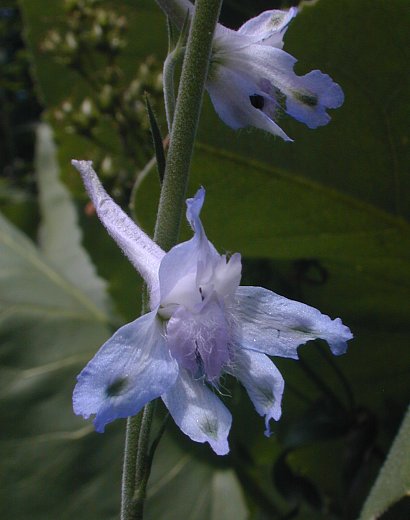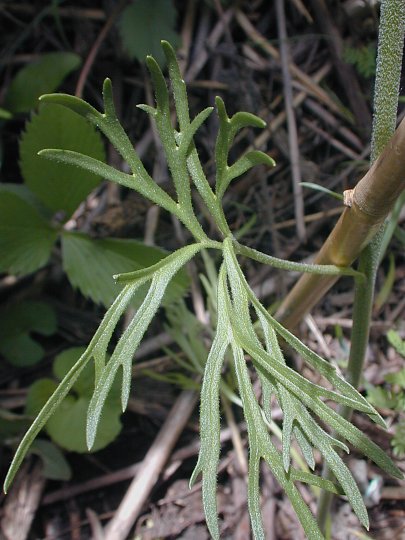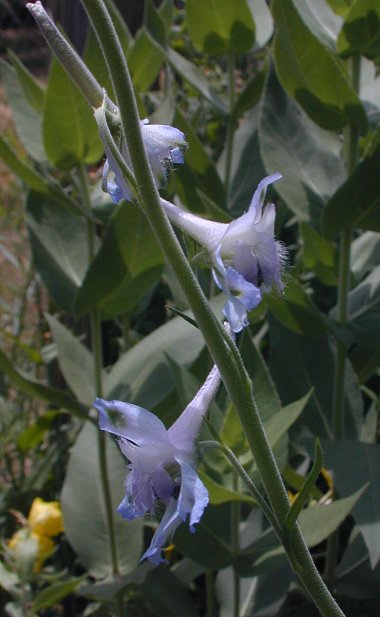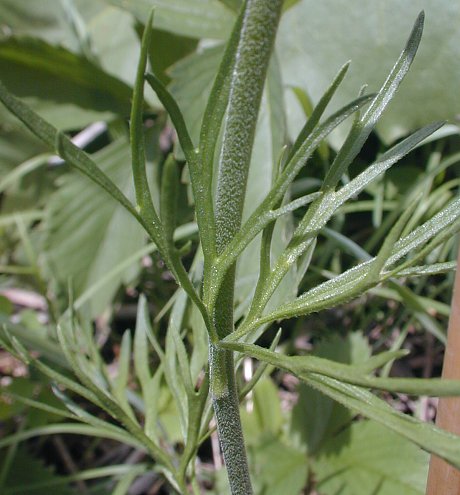Description: This perennial wildflower is 1½–3' tall, consisting of some basal leaves and a flowering stem with alternate leaves. The basal leaves are up to 4" long and 4" across; each basal leaf is palmately divided into 3-5 segments, and each of these segments are subdivided into linear lobes about 3-4 mm. across. The slender petioles of the basal leaves are up to 4" long. The alternate leaves are similar in appearance to the basal leaves, except they become smaller while ascending the stem and their petioles are shorter. The basal leaves, alternate leaves, and the petioles are finely pubescent and whitish green to green. The central stem is terete, short-pubescent, and whitish green; it is unbranched or sparingly branched where the floral racemes occur. The central stem terminates in an elongated raceme of flowers about ½–1' long; sometimes there are 1 or 2 lateral racemes that are shorter. Individual flowers are about 1" long and 1" across; depending on the local ecotype, they vary in color from light blue to deep blue-violet.

Each flower consists of 5 sepals, 4 petals, 3 pistils, and numerous stamens. The petal-like sepals spread outward and they have rounded tips; the base of the uppermost sepal forms the ascending nectar spur, which curves upward. Near the tip of each sepal, there is often a patch of green. The small upper petals form a short hood over the throat of the flower and their bases extend into the nectar spur; they are often more white or light-colored than the lower petals or sepals. The lower petals are cleft and covered with fine woolly hairs; sometimes they are slightly purple. The pedicel of each flower is about 1" long and ascending; it has a pair of tiny linear bracts toward the middle. Near the base of each pedicel, there is a single linear bract that is larger in size and ascending. The blooming period occurs from late spring to early summer and lasts about 3-4 weeks. Each flower lasts about 1 week; several flowers are often in bloom at the same time. Each flower is replaced by a cluster of 3 seedpods (technically, follicles) that are joined together at the base. The individual seedpods are about ½–¾" long, angular in shape, and beaked; they are held erect. Each seedpod splits open along the inner side to release its seeds. The angular seeds are short-oblongoid with appressed scales; they are slightly winged along their margins. The root system is coarsely fibrous. Reproduction is by seed.

Cultivation:
The preference is full sun, rather dry conditions, and soil that is
rocky or sandy. This wildflower dislikes competition and prefers barren
ground where the ground vegetation is sparse. If necessary, it can
tolerate a little shade. The basal leaves usually wither away before
the flowers bloom, but this is normal.
Range & Habitat:
The native Wild Larkspur is restricted to a few counties in western and
central
Illinois (see Distribution
Map); it is uncommon. Two subspecies have been observed in
Illinois. One of them, Delphinium carolinianum virescens
(Prairie Larkspur), was collected in Hancock County by Dr. Mead during
the 19th century; it may be extirpated from the state. The typical
subspecies, Delphinium carolinianum carolinianum
(Wild Larkspur), has been collected from the remaining counties.
Prairie Larkspur is more common in areas to the west of the Mississippi
River, while Wild Larkspur is more common in the southeastern and
south-central states. Habitats include hill prairies, upland sand
prairies, rocky glades, barren savannas, and rocky openings in upland
woodlands.

Faunal
Associations:
Bumblebees suck nectar from the flowers and help to cross-pollinate
them. Insects that feed on Delphinium spp.
(Larkspurs) include flower-eating larvae of a moth, Heliothis
phloxiphagus (Dark-Spotted Straw), leaf-mining larvae of an
Agromyzid fly (Phytomyza aconiti), and an aphid
(Brachycaudus rociadae).
This latter insect sucks sap from the stems and leaves. Because the
foliage of Wild Larkspur (Delphinium
carolinianum) is more or less toxic
to mammalian herbivores, it is usually avoided by them.
Photographic Location:
The wildflower garden of the webmaster in Urbana, Illinois.

Comments: The flowers of this species are quite attractive – how unfortunate that it isn't more common! The only other larkspur that is native to Illinois, Delphinium tricorne (Dwarf Larkspur), is found primarily in woodlands in the southern half of the state. This latter species has shorter flowering stalks and leaves with wider lobes (exceeding ¼" across); furthermore, its seed capsules are widely spreading, rather than erect. An annual species from Europe that is grown in gardens, Consolida ajacis (Rocket Larkspur), occasionally escapes into waste areas. This species has leaves with lobes that are nearly filiform (worm-like) and it has only one seed capsule per flower. In contrast, each flower of Wild Larkspur matures into clusters of 3 seed capsules. The typical subspecies of Wild Larkspur, Delphinium carolinianum carolinianum, has been described above. The other subspecies that has been found in Illinois, Delphinium carolinianum virescens (Prairie Larkspur), differs from the typical subspecies as follows: 1) Its flowers tend to be more white (varying from white to light blue), 2) Its basal leaves usually don't wither before the flowers bloom, and 3) Its seeds have projecting scales, while lacking wings along their margins. Sometimes Prairie Larkspur is regarded as a distinct species, in which case it is referred to as Delphinium virescens. Wild Larkspur and Prairie Larkspur occasionally hybridize when they occur together in the same area.